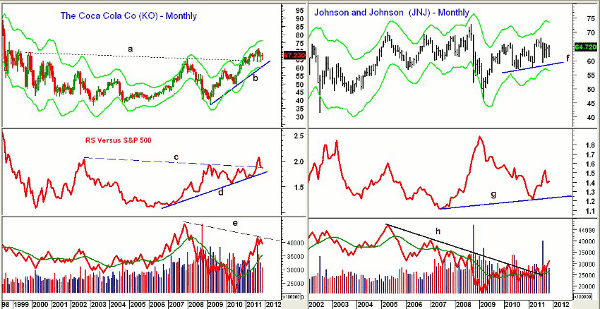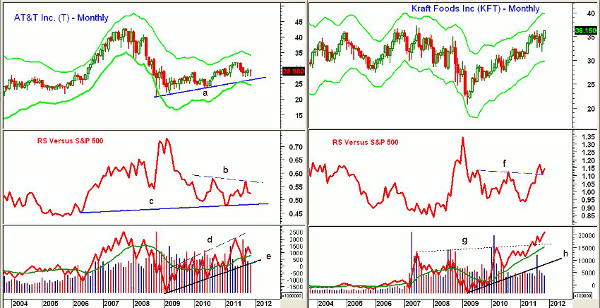Despite a strong November close, these big, dividend-paying Dow stocks have plenty of leftover upside potential and are safer buys than attractive but more volatile small-cap stocks.
Wednesday’s record gains helped most stocks close near their highs for November, yet the month-end scan of the stocks in the Dow Industrials reveals that many are still far from overbought levels. Many of these large-cap stocks also offer attractive yields.
I use Starc band analysis to identify overbought and oversold conditions. When a market or equity is close to its upper monthly Starc band (Starc+), it is a high-risk time to buy and considered overbought. Conversely, when close to the lower monthly Starc band (Starc-), it is a low-risk time to buy and considered oversold.
In October (see “The Most Oversold Dow Stocks”), Caterpillar Inc. (CAT) was the most oversold stock, as it closed September 30 at $73.84, which was just 0.3% above the monthly Starc- band at $73.64. CAT closed Wednesday at $97.88 and is up over 32% in the past two months.
The table above lists the ten most oversold Dow stocks based on the proximity to their monthly Starc- band as of the end of November. The first stock on the list is Coca-Cola Co. (KO), which is 11% above its monthly Starc- band. While KO is not nearly as oversold as Caterpillar was in October, it would still take a 13% rally to take KO to its monthly Starc+ band.
NEXT: Latest Chart for Coca-Cola; More Dow Leaders
|pagebreak|Chart Analysis: Coca-Cola Co. (KO), which yields 2.8%, has held in a fairly tight range over the past four months, testing support in the $63.30-$63.60 area, line a, several times. The monthly uptrend, line b, is at $60.70 with the Starc- band just under $60.
- Monthly relative performance, or RS analysis, broke through nine-year resistance last summer, line c, and has just pulled back to the breakout level
- The weekly RS (not shown) is in a well-defined uptrend
- Monthly on-balance volume (OBV) is well above its rising weighted moving average (WMA) but has not been able to move above the highs from 2007, line e. The weekly OBV (not shown) is also positive
- Once above the September highs at $71.77, there is resistance from 1998 at $75.44
Johnson & Johnson (JNJ) has a yield of 3.6%. Over the past three months, the low for the stock has been $60.83, which is the first key level of support. Further support stands at $58.60.
- The RS line surged in 2009 as JNJ tested its Starc-band but still was outperforming the S&P 500. The RS turned up in November and needs to hold support at line g
- Monthly OBV has improved this fall, breaking its long-term downtrend, line h, and turning up sharply last month
- Weekly OBV (not shown) shows a longer-term uptrend but is still below its weighted moving average
- There is initial resistance at $65-80-$66.23, and a close above this level will suggest a rally to the $68 area with the monthly Starc+ band at $73.53
NEXT: Oversold Dow Leader with a Big Yield
|pagebreak|AT&T Inc. (T) is one of few stocks less volatile than JNJ, but it has a much higher yield at 6.8%. Many investors are avoiding the stock until the merger with T-Mobile is resolved, but technically, it does look interesting.
- There is support from the last four months at $27.29 with the long-term monthly trend line support, line a, now at $26.20. The Starc- band is at $24.55
- Monthly RS has been in a trading range since the middle of 2010 and a move above line b would be very positive
- Monthly OBV shows a strong uptrend, line e, from the 2009 lows. It has formed higher highs, line d, and is acting stronger than prices
- Weekly OBV (not shown) has been below its weighted moving average since July and is now closer to turning positive
- There is first resistance at $29.80-$29.90, which, if overcome, should signal a move to the $31.70-$32 area. The Starc+ band is at $34.10
Kraft Foods Inc. (KFT) yields 3.3% and gapped sharply higher on Wednesday, closing at the daily Starc+ band. The November close was the highest since 2002. KFT was featured last month when it retested the monthly breakout level. The monthly Starc+ band is at $39.90 with resistance from 2001-2002 at $41.30-$43.
- The RS line broke through resistance, line f, at the end of August, which was a very positive sign
- Monthly OBV also broke through resistance last summer (line g) and is acting very strong
- Weekly OBV (not shown) has been positive since early in the year
- There is first support for KFT at $35.50 with more important support in the $33.75-$34.25 area
What It Means: Over the past few months, the Dow Industrials’ Advance/Decline (A/D) line has been the strongest, and these high-yielding large-cap stocks are still favored by many. They continue to look attractive, especially for those who are underinvested in stocks but can’t stomach the wild gyrations of the high-growth or small-cap stocks.
One advantage of using monthly charts is that it is often easier to identify key support and resistance levels. If any of these four stocks were to break below the three-month lows, it would clearly weaken them technically.
How to Profit: For Coca-Cola Co. (KO), buy at $66.24 or better with a stop at $62.76 (risk of approx. 5.3%).
For Johnson & Johnson (JNJ), buy at $62.88 or better with a stop at $60.34 (risk of approx. 4%).
For AT&T Inc. (T), buy at $28.54 or better with a stop at $26.90 (risk of approx. 5.7%).
Kraft Foods Inc. (KFT) was recommended last month (see below), but for those who are not currently long, buy at $35.54 or better with a stop at $33.52 (risk of approx. 5.7%).
Portfolio Update
For Kraft Foods (KFT), previous buyers should be 50% long at $34.54 and using a stop at $33.52.
For International Business Machines (IBM), buyers should be 50% long at $178.72. Raise the stop on that position to $174.32.
For Intel (INTC), buyers should be 50% long at $23.24. Raise the stop on that position to $22.34.





















